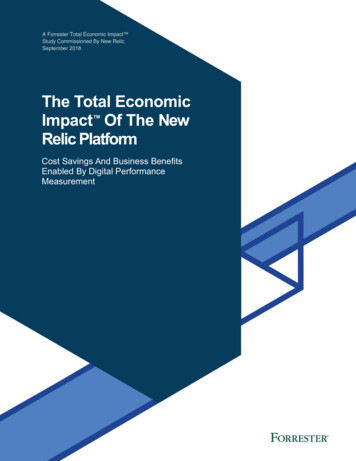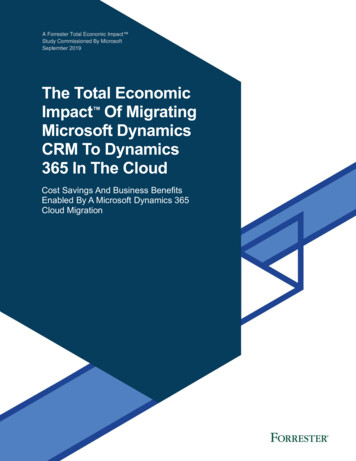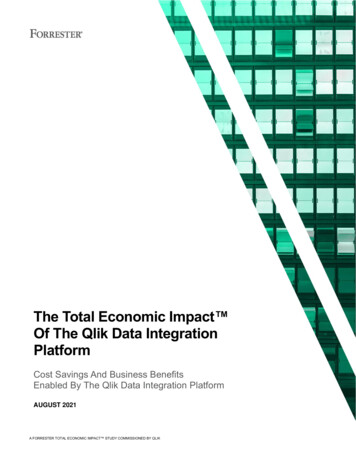
Transcription
A Forrester Total Economic Impact Study Commissioned By New RelicSeptember 2018The Total EconomicImpact Of The NewRelic PlatformCost Savings And Business BenefitsEnabled By Digital PerformanceMeasurement
Table Of ContentsExecutive SummaryKey Findings11TEI Framework And Methodology4The New Relic Customer JourneyInterviewed Organization55Key Challenges5Solution Requirements5Key Results6Analysis Of BenefitsLabor Resources Reassigned (MTTR Cost Savings)88Decommissioned Tools9Labor Resources Reassigned (Decommissioned Tool Maintenance)10Scalability (Infrastructure Cost Avoidance)11Unquantified Benefits11Flexibility12Analysis Of CostsNew Relic Usage Fees1414New Relic Setup Costs14Professional Services From New Relic15Financial SummaryThe New Relic Platform: OverviewAppendix A: Total Economic ImpactProject Director:Jeffrey NorthAssociate Consultant:Connor Maguire171819ABOUT FORRESTER CONSULTINGForrester Consulting provides independent and objective research-basedconsulting to help leaders succeed in their organizations. Ranging in scope from ashort strategy session to custom projects, Forrester’s Consulting services connectyou directly with research analysts who apply expert insight to your specificbusiness challenges. For more information, visit forrester.com/consulting. 2018, Forrester Research, Inc. All rights reserved. Unauthorized reproductionis strictly prohibited. Information is based on best available resources.Opinions reflect judgment at the time and are subject to change. Forrester ,Technographics , Forrester Wave, RoleView, TechRadar, and Total EconomicImpact are trademarks of Forrester Research, Inc. All other trademarks are theproperty of their respective companies. For additional information, go toforrester.com.
Executive SummaryBenefits And Costs“We’re pushing it so far left now we’re catching these issues in the developmentenvironment. It’s helping us to solve issues before they impact automated testingor things down the line that may cause more rework and slow down deploymentsor increase the lead time to get a deployment out the door. We’re shifting as muchleft as possible where it’s cheaper to fix a problem. And we’re trying to do it witheverything, even automated tests. Anything we can push further left makes usfaster.” - Software development tech consultant, financial services firmFewer incidents, fasterresolution: 6,515,432Decommissioned obsolete tools: 4,706,236New Relic provides a suite of measurement instruments that helpsorganizations measure their Agile plus DevOps performance, adopt thecloud faster, and gather insight into their digital performance related tocustomer experience. New Relic commissioned Forrester Consulting toconduct a Total Economic Impact (TEI) study and examine the potentialreturn on investment (ROI) enterprises may realize by deploying the NewRelic Platform. The purpose of this study is to provide readers with aframework to evaluate the potential financial impact of New Relic on theirorganizations’ Agile, DevOps, cloud adoption, and customer experienceinitiatives.To better understand the benefits, costs, and risks associated with thisinvestment, Forrester interviewed one large enterprise customerorganization with several years of experience using New Relic tools.Labor and infrastructure costsavoided: 1,727,461Prior to using the New Relic Platform, the profiled enterprise had limitedDevOps performance monitoring capability due to the cost and complexityof its small set of DevOps tools. These limitations led to a search for amodern suite of performance monitoring tools, resulting in the deploymentof New Relic after extensive search, evaluation, and proof of concept. WithNew Relic, the organization gained an end-to-end view of its DevOpsportfolio, shifting application performance monitoring (APM) further left toapplication developers, with a complete view from the browser through theapplication as well as its infrastructure.Key FindingsQuantified benefits. The interviewed organization experienced thefollowing risk-adjusted present value (PV) quantified benefits:New Relic usage, setup, servicescosts: 6,047,192› Labor cost savings from fewer incidents and reduced MTTR (meantime-to-resolution). Cost savings resulting from fewer IT resourcesfixing problems faster (and earlier in the development/operations lifecycle) produced 6.5 million in present value over three years.› Decommissioning obsolete monitoring tools. Simply by replacingolder, expensive, complicated monitoring tools, the company saved anestimated 4.7 million in license and maintenance costs.› IT resources reassigned from decommissioned tool maintenance.The company also saved 1.7 in IT labor cost savings for the care of oldtools.› Infrastructure costs avoided. Moving to New Relic’s cloud-basedAPM-as-a-service allowed the company to avoid a new investment inon-premises storage/compute devices.1 The Total Economic Impact Of The New Relic Platform
Unquantified benefits. The interviewed organization experienced thefollowing benefits, which are not quantified for this study:ROI120%Benefits PV 13.3 millionNPV 7.2 million› Better business decisions. Dashboards and insight enable thecompany to focus on actual customer behavior and more intelligentlyprioritize work. By using the metrics and visibility that New Relicprovides, the company can drive good business decisions› Lower frustration, greater DevOps job satisfaction. Due to asimplified, more intelligent, more satisfying, and less frustrating DevOpswork environment, IT staff are more efficient and effective, and thus gaingreater job satisfaction.› Eliminating Business Disruption. Reducing the number ofinterruptions to normal business practices can prove to be an invaluableasset. Lost productivity due to business interruptions can posesignificant cost to companies. Additionally, these business interruptionscan cause friction in the customer experience which could negativelyaffect a company’s public image.Costs. The interviewed organization experienced the following riskadjusted PV costs:Payback8 months› New Relic usage fees. The company spent 4.9 million in present valueterms over three years on usage fees.› Setup and deployment. The company spent 922,000 for the initialsetup and subsequent rollout of New Relic.› Professional services. The company spent 230,000 in the first sixmonths on professional services to accelerate the setup anddeployment.Forrester’s interview with an existing customer and subsequent financialanalysis found that the interviewed organization experienced benefits of 13,277,754 over three years versus costs of 6,047,192 adding up to anet present value (NPV) of 7,230,562 and an ROI of 120%. SECTION BREAK AFTER THIS PARAGRAPH!!!2 The Total Economic Impact Of The New Relic Platform
Financial SummaryTotal benefitsPV, 13.3MPayback:8 monthsTotal costsPV, 6.0MInitialYear 1Year 2Year 3Benefits (Three-Year) 6.5M 4.7M 1.7M 328.6KLabor resourcesDecommissioned toolsLabor resourcesreassigned (MTTR costreassignedsavings)(decommissioned toolmaintenance)3 The Total Economic Impact Of The New Relic PlatformScalability(infrastructure costavoidance)
TEI Framework And MethodologyFrom the information provided in the interview, Forrester has constructed aTotal Economic Impact (TEI) framework for those organizationsconsidering implementing the New Relic Platform.The objective of the framework is to identify the cost, benefit, flexibility, andrisk factors that affect the investment decision. Forrester took a multistepapproach to evaluate the impact that the New Relic Platform can have onan organization:The TEI methodologyhelps companiesdemonstrate, justify,and realize thetangible value of ITinitiatives to bothsenior managementand other keybusinessstakeholders.DUE DILIGENCEInterviewed New Relic stakeholders and Forrester analysts to gather datarelative to the New Relic PlatformCUSTOMER INTERVIEWInterviewed one organization using the New Relic Platform to obtain datawith respect to costs, benefits, and risks.FINANCIAL MODEL FRAMEWORKConstructed a financial model representative of the interview using theTEI methodology and risk-adjusted the financial model based on issuesand concerns of the interviewed organization.CASE STUDYEmployed four fundamental elements of TEI in modeling New Relic’simpact: benefits, costs, flexibility, and risks. Given the increasingsophistication that enterprises have regarding ROI analyses related to ITinvestments, Forrester’s TEI methodology serves to provide a completepicture of the total economic impact of purchase decisions. Please seeAppendix A for additional information on the TEI methodology.DISCLOSURESReaders should be aware of the following:This study is commissioned by New Relic and delivered by ForresterConsulting. It is not meant to be used as a competitive analysis.Forrester makes no assumptions as to the potential ROI that otherorganizations will receive. Forrester strongly advises that readers use their ownestimates within the framework provided in the report to determine theappropriateness of an investment in New Relic.New Relic reviewed and provided feedback to Forrester, but Forrestermaintains editorial control over the study and its findings and does not acceptchanges to the study that contradict Forrester’s findings or obscure themeaning of the study.New Relic provided the customer name for the interview but did not participatein the interview.4 The Total Economic Impact Of The New Relic Platform
The New Relic Customer JourneyBEFORE AND AFTER THE NEW RELIC INVESTMENTInterviewed OrganizationFor this study, Forrester interviewed subject matter experts at a NewRelic customer organization that:› Is a multibillion-dollar financial services company.› Is known for advanced digital innovation and enterprise collaboration.› Has over 4,000 employees in IT roles.Key ChallengesThe IT infrastructure leader interviewed for this study described a rangeof challenges and opportunities that drove this organization’s decision toinvest in and implement New Relic’s DevOps measurement tools.› Prior tools needed replacement. New Relic replaced a collection oftools that had been used for infrastructure and application performancemonitoring and incident alerting. The old tools had become largelyobsolete. Worse, they were complicated, costly, and used by only afew IT ops staff. “Before [New Relic], DevOps was only Ops. The toolkit wasn’t easy to use; it wasn’t easy to get the data and the views thatthe developers needed, so they didn’t use the tools. They called theoperations folks and had them look at [incidents],” noted aninterviewee. “We had two [main] tools; we had synthetics and then wealso had basic server monitoring CPU with disk memory-type stats,and that was it. The diagnostics tool was used in very limited areasbecause everybody was frankly afraid of it, with a lot of performanceoverhead to their applications. But it was used in just a few apps inproduction. Only a few people know how to use it. And along with theperformance implication, it was expensive, very expensive. So, peoplejust weren’t using the tools. And synthetics usage was even on lighter.”› Coverage was limited. New Relic tools currently monitor nearly 1,700applications, with plans for that number to grow to 4,000. Previoustools reviewed only 30 apps at one time, and monitoring tools would beturned off due to heavy compute overhead. Approximately 1,000 endusers work with New Relic tools, compared to about 100 IT staff whoheld active licenses for the old tools.› IT strategy needed support. The company’s IT strategy includes: 1)reducing the time it takes to get apps into production; 2) carrying outmore frequent deployments; 3) automating everything whereverpossible; and 4) increasing the use of telemetry to quickly pinpoint andfix problems earlier in the dev cycle. New Relic has been instrumentalin making progress against those tenets.Solution RequirementsThe interviewed organization searched for a solution that could offer:5 The Total Economic Impact Of The New Relic Platform“We use all of the New Relictools. Our people only used aportion of the previous toolset.”Technology planner“Our old tools were not cuttingit. New Relic is a majorcapability uplift.”Technology planner“The end user experiencemonitoring was new for us, soto have that browser-leveldetail was huge.”Software development techconsultant
› End-to-end views of development and operations, with thecapability to drill down from browser to app to server and into theinfrastructure, to analyze and resolve performance issues anywhere,but especially early in the development process.› Ease of use, so that end users could make sense of the tools andteams could share them.› Always-on telemetry, which is a huge improvement over monitoringtools that are switched on only periodically.› Portability, meaning a tool that is easy to move along withapplications, such as from on-premises to a cloud-computing platform,and back, without any kind of refactoring or any kind of newinfrastructure.› Low compute overhead, without causing problems or conflicts withthe applications being monitored.After gathering requirements, an extensive request for proposal (RFP)and proof-of-concept (POC) process evaluating multiple vendors, theinterviewed organization chose New Relic and began deployment.Key ResultsThe interview and analysis revealed several key results from the NewRelic investment:› New Relic led to a 30% reduction in MTTR. Mean-time-to-resolutiondropped significantly. While the previous tools typically required a ticketand a team to fix a problem, the New Relic tools offer immediate viewsand involve fewer people. Now development and/or operations teamscan zero in on the problem and engage only those needed. This allowsmany IT staff to redirect their efforts toward the business instead of theinfrastructure and apps.› New Relic eliminated the need to scale company’s on-premisesinfrastructure. New Relic’s cloud provisioning removes the need toplan, purchase, and manage compute and storage resources.› New Relic enabled the company to achieve its four pillars ofDevOps. New Relic has been an asset for making progress on thecompany’s stated goals for its DevOps organization: 1) reduce the timeit takes to get apps into productions; 2) deliver more frequentdeployments; 3) automate wherever possible; and 4) use telemetry tolocate and fix problems quickly.6 The Total Economic Impact Of The New Relic Platform“Everybody is using New Relic.Heck, I’ve got managers usingit. They can go in and look atthe dashboard and see howwell their application’s doing.We’ve got business usersusing it now where we putsome business metrics into adashboard. So, I mean, it’seven gone beyond Dev andOps.”Software development techconsultant
› New Relic is now considered a must-have for all new applications.After seeing New Relic’s value to the company’s DevOps organization,the company is rolling the solution out to all corners of the ITenvironment. “[The ubiquity of New Relic] was one of the big draws forus,” noted the interviewee for this study. “The visibility that people hadnever had before, with always-on telemetry. . . . Before, we only hadspotty telemetry. If you wanted an infrastructure metric, you had to putin a request, if it was beyond the very basics: CPU, disk, and memory.New Relic has become more of as-a-service because telemetry isalways on; it’s always there. It’s easy to use; the panels seem moredeveloper-centric with somewhat less emphasis on infrastructure andoperations, but teams can share the tool. Both Dev and Ops get value,and we’re both on the same page. Before, it was siloed, and only a fewteams used the tools.”7 The Total Economic Impact Of The New Relic Platform“New Relic is like antivirussoftware. It’s now required forall new apps.”Software development techconsultant
Analysis Of BenefitsQUANTIFIED BENEFIT DATATotal BenefitsYEAR 2YEAR 3TOTALPRESENTVALUE 1,989,000 2,983,500 2,983,500 7,956,000 6,515,432Decommissioned tools 900,000 2,250,000 2,700,000 5,850,000 4,706,236CtrLabor resources reassigned(decommissioned toolmaintenance) 425,000 850,000 850,000 2,125,000 1,727,461DtrScalability (infrastructure costavoidance) 90,000 135,000 180,000 405,000 328,625Total benefits (risk-adjusted) 3,404,000 6,218,500 6,713,500 16,336,000 13,277,754REF.BENEFITAtrLabor resources reassigned(MTTR cost savings)BtrYEAR 1Labor Resources Reassigned (MTTR Cost Savings)When asked about the value of New Relic to this organization, the ITleader interviewed for this study explained: “The big one is MTTR. That’sbecause the prior tools required a ticket, and you had to engage anotherteam, and it took much longer to reduce or to resolve an issue. So, afterwe dropped in New Relic, everybody, whoever needs it, has visibility intothe applications, so we were able to reduce MTTR. That’s mostly labor.It’s the number of people who aren’t involved or involved for a muchshorter period.The table above shows the total of allbenefits across the areas listed below,as well as present values (PVs)discounted at 10%. Over three years,the interviewed organization expectsrisk-adjusted total benefits to be a PVof more than 13.3 million.“Before New Relic, we called in everyone to fix an incident,” hecontinued. “You were guilty until you prove yourself innocent. We wouldhave everybody on the phone and in the room until we figured out wherethe root cause was. Now, with New Relic, we can zoom in on where theproblem is and only engage the folks that need to be engaged.”Related to this benefit category:› All-hands emergency “Crit Sit” problem resolution sessions droppedfrom 1200 to 800 per year. 6.5 million 6.5 millionthree-yearthree-yearbenefit PVbenefit PV49%› The number of incidents dropped by 30% Year 2 of the New Relicimplementation.› The average time-to-resolve incidents dropped.› Overall reduction in resolution costs was estimated at 30%.“Now, we always get only the right people . . . because with New Relic,we can tell if SQL performance is declining, and we can engage theOracle teams, or we can tell that external services are running slowly sowe might engage our SOA team,” explained one of the softwaredevelopment tech consultants who is now helping the organizationrealize New Relic DevOps benefits.The table below shows the assumptions and calculations for this benefit8 The Total Economic Impact Of The New Relic PlatformMTTR cost savings: 49%of total benefits
category.› Many members of the IT organization were involved in the resolution ofeach “Crit Sit.” Involvement could range from 15-30 individuals foreach event.› The number of incidents avoided increased from 8 to 12 in Year 2.› Incidents formerly took 5 hours to resolve.› IT compensation was 75.00 per hour ( 150,000 fully loaded annualcompensation).Impact risk is the risk that the businessor technology needs of theorganization may not be met by theinvestment, resulting in lower overalltotal benefits. The greater theuncertainty, the wider the potentialrange of outcomes for benefitestimates.Avoided costs related to MTTR reductions will depend on:› The number and complexity of apps covered by New Relic.› Number of IT staff involved in the resolution “Crit Sit” event.› The average fully burdened salary (seniority) of IT staff involved.To account for these risks, Forrester adjusted this benefit downward by15%, yielding a three-year risk-adjusted total PV of 6,515,432.Labor Resources Reassigned (MTTR Cost Savings): Calculation TableREF.METRICA1A2CALC.YEAR 1YEAR 2YEAR 3Hours per incident saved across IT teams757575Average incidents per week prior to New Relic232323151111A3Average incidents per week with New Relic30% decrease inYear 2Source: customerinterviewA4Average incidents avoided per weekA2-A381212A5Average hours per incident savedA1*A4600900900A6Fully loaded hourly compensation 75.00 75.00 75.00AtLabor resources reassigned (MTTR costsavings)A5*A6*52 2,340,000 3,510,000 3,510,000Risk adjustment 15% 1,989,000 2,983,500 2,983,500AtrLabor resources reassigned (MTTR costsavings) (risk-adjusted)Decommissioned ToolsPrior to implementing New Relic, the company employed tools forsynthetics, basic server monitoring for CPU and disk monitoring metrics,and some limited diagnostics for a few apps in the productionenvironment. “Everybody was afraid of the old tools,” explained theDevOps technology planner interviewed for this study. “The few staff whoknew how to use the tools were afraid of the performance overhead totheir applications. Put it all together, and the people just weren’t usingthe tools.”9 The Total Economic Impact Of The New Relic Platform
The organization was able to decommission old tools and reallocatethose license, maintenance, and labor operating expenses to otherneeds in the organization. 4.7 millionFor the interviewed organization, Forrester assumes that the old tools isable to fully decommissioned by the end of Year 2.three-yearbenefit PV35%The reduction in software development expense will vary with:› The rate at which decommissioning takes place versus plan.› The staff levels needed to disengage old tools.› Communications and setting expectations with tool owners and users.Decommissioned tools:35% of total benefitsTo account for these risks, Forrester adjusted this benefit downward by10%, yielding a three-year risk-adjusted total PV of 4,706,236 million.Decommissioned Tools: Calculation TableREF.METRICCALC.YEAR 1YEAR 2YEAR 3BtDecommissioned tools (licenses,maintenance)Est. based oninterviews 1,000,000 2,500,000 3,000,000Risk adjustment 10% 900,000 2,250,000 2,700,000BtrDecommissioned tools (risk-adjusted)Labor Resources Reassigned (DecommissionedTool Maintenance)After rolling out New Relic, the company has saved the cost of IT laborbecause staff no longer need to feed and care for high-maintenancetools, as described above, for synthetics, basic server monitoring forCPU and disk monitoring metrics, and some limited diagnostics for a fewapps in the production environment. “On the I&O side, they used tospend a lot of time with messing with the infrastructure, dealing with thehardware and keeping the software current, maintenance — regularmaintenance that they had to do with the old tool ‘suite.’ That’s now goneaway, so they’re not doing that anymore. It’s all software-as-a-service.They’re more focused on getting the business value out of the tool. Sothey’re doing training sessions, they’re helping with synthetic scripts,they’re helping to guide the applications on how to further instrument toget more value out of the APM data. So they’re building dashboards.They’re doing a lot of different things, but it’s more business value out ofit versus maintenance of the software and hardware.”For the interviewed organization, Forrester assumes that the old toolswere fully decommissioned by the end of Year 2.The reduction in maintenance labor expense will vary because:› Decommissioning might not take place as quickly as planned.› Estimated compensation could be higher than for those performingthese maintenance tasks.To account for these risks, Forrester adjusted this benefit downward by15%, yielding a three-year risk-adjusted total PV of 1,727,461.10 The Total Economic Impact Of The New Relic Platform13% 1.7millionIT ResourcesthreeReassigned:year13% of total benefitsIT resources reassigned:13% of total benefits
Labor Resources Reassigned (Decommissioned Tool Maintenance)REF.METRICC1YEAR 1YEAR 2YEAR 3Number of IT staff51010C2Yearly rate per person 100,000 100,000 100,000CtLabor resources reassigned(decommissioned tool maintenance)C1*C2 500,000 1,000,000 1,000,000Risk adjustment 15% 425,000 850,000 850,000CtrCALC.Labor resources reassigned(decommissioned tool maintenance) (riskadjusted)Scalability (Infrastructure Cost Avoidance)3%With the adoption of New Relic, client organizations no longer need toplan, purchase, or maintain on-premises infrastructure for their DevOpsmonitoring tools. New Relic is on point for accommodating andexpanding this infrastructure. For this benefit category, Forresterassumes that the company avoided 10, 15, and 20 compute/storagedevices over the three years, at an annual fully loaded (purchase,license, maintenance, etc.) cost of 10,000 each. 328,625To account for any risk of overestimating this benefit, Forrester adjustedthis benefit downward by 10%, yielding a three-year risk-adjusted totalPV of 328,625.Infrastructure costs avoided:3% of total benefitsthreeyearScalability (Infrastructure Cost Avoidance): Calculation TableREF.METRICCALC.YEAR 1YEAR 2YEAR 3D1Number of on-premises storage/computedevicesInterviews101520D2Cost per deviceAssumption 10,000 10,000 10,000DtScalability (infrastructure cost avoidance)D1*D2 100,000 150,000 200,000Risk adjustment 10% 90,000 135,000 180,000DtrScalability (infrastructure cost avoidance) (riskadjusted)Unquantified BenefitsThis study attempts to quantify those benefits that were mostcompellingly articulated by the New Relic customer that participated inthe research. Some benefits, described below, are more speculative andmay be evaluated and quantified in the future as the organization gainsmore experience with New Relic.11 The Total Economic Impact Of The New Relic Platform
› Better business decisions. When application owners can see thepaths that their customers are taking to reach and navigate through anapp, they can focus on that behavior and more intelligently choosewhere to prioritize their work. For example, one of the teams recountedhow it can determine the specific path that users take through an app.In one instance, the business wanted the team to do a customer-facingproject, but using the browser monitoring, the IT team found that it wasrelated to an infrequently used path through the application, and thecost to do the enhancement would not get the return on investmentthat the business expected. By using the metrics that New Relicprovides, companies can drive good business decisions.› Lower frustration, greater job satisfaction. When a New Reliccustomer replaces legacy tools and amends DevOps processes, ITstaff benefit from an enriched platform from which to serve theircustomers. These employees can be more efficient and effective, andthus gain greater job satisfaction due to a simplified, more intelligent,more satisfying, and less frustrating DevOps work environment.Automation reduces the strain and allows staff to focus on businessvalue and business results. The likely result is lower frustration, greaterjob satisfaction, higher retention, and lower cost of recruiting andreplacing staff.› Happy customers through shorter lead times for new features.The financial services company described an example of customerexperience enhancement via New Relic in the form of a feature relatedto quoting and binding insurance coverage for the company’s insuredcustomers. A new app can show the flow from start of quote, throughmultiple points in the process, to how many people bind new insurancecoverage. “It’s very cool to be able to see it in real time and without anyadditional instrumentation in your application or anything like that. Wecan just watch it in New Relic, and when we know more about ourcustomer, we can offer more and better service and products.” Moreexamples and demonstrations of value in the customer experiencedomain can be exploited in the future.FlexibilityThe value of flexibility is clearly unique to each customer, and themeasure of its value varies from organization to organization. There aremultiple scenarios in which a customer might choose to implement NewRelic and later realize additional uses and business opportunities,including:12 The Total Economic Impact Of The New Relic PlatformFlexibility, as defined by TEI,represents an investment in additionalcapacity or capability that could beturned into business benefit for a futureadditional investment. This provides anorganization with the "right" or theability to engage in future initiatives butnot the obligation to do so.
› Cloud migration. In addition to the myriad of benefits offered throughthe implementation of New Relic for DevOps, further involving NewRelic in organizational processes can pay even more dividends.Including New Relic in application production and in cloud migrationextends optimization of application performances. According to NewRelic, use of this service can accelerate the time it takes to bring anapplication to the “run” phase of migration and leads to infrastructureand engineering cost reductions. Organizations achieve this byequipping customers with a comprehensive view of each app’smigration path using various dashboards, tools, and metrics. Theseviews allow customers to more easily evaluate each app’s migrationpath and oversee the deployment of the app while also monitoring theperformance and operation of each project. A holistic view ofapplication migration expounds on the insights provided by theDevOps platform and allows for further improvements in processefficiencies.› Enhancing customer experience. The next area of value realizationfrom the changes in this company’s DevOps and digital transformationefforts will be customer experience. Even at this stage of thecompany’s experience with New Relic, the company has seen severalexamples of customer experience enhancement. “We wouldn’t do allthis if we weren’t doing it for our customers or suppliers,” said oneinterviewee. “For example, we are automating everything, so we canfree up our people to do higher-level stuff that’s going to result in morecompetitive decisioning, better and more products, less chance ofhuman error, and taking cost out of our businesses. And if thechairman wants to double the size of one of our businesses, well, NewRelic is going to help us do that.” Another example: The claimsdepartment built a new product during a recent natural catastrophe,adding a new feature and functionality into a customer-facing app androll
of New Relic after extensive search, evaluation, and proof of concept. With New Relic, the organization gained an end-to-end view of its DevOps portfolio, shifting application performance monitoring (APM) further left to application developers, with a complete view from the browser through the application as well as its infrastructure. Key Findings











